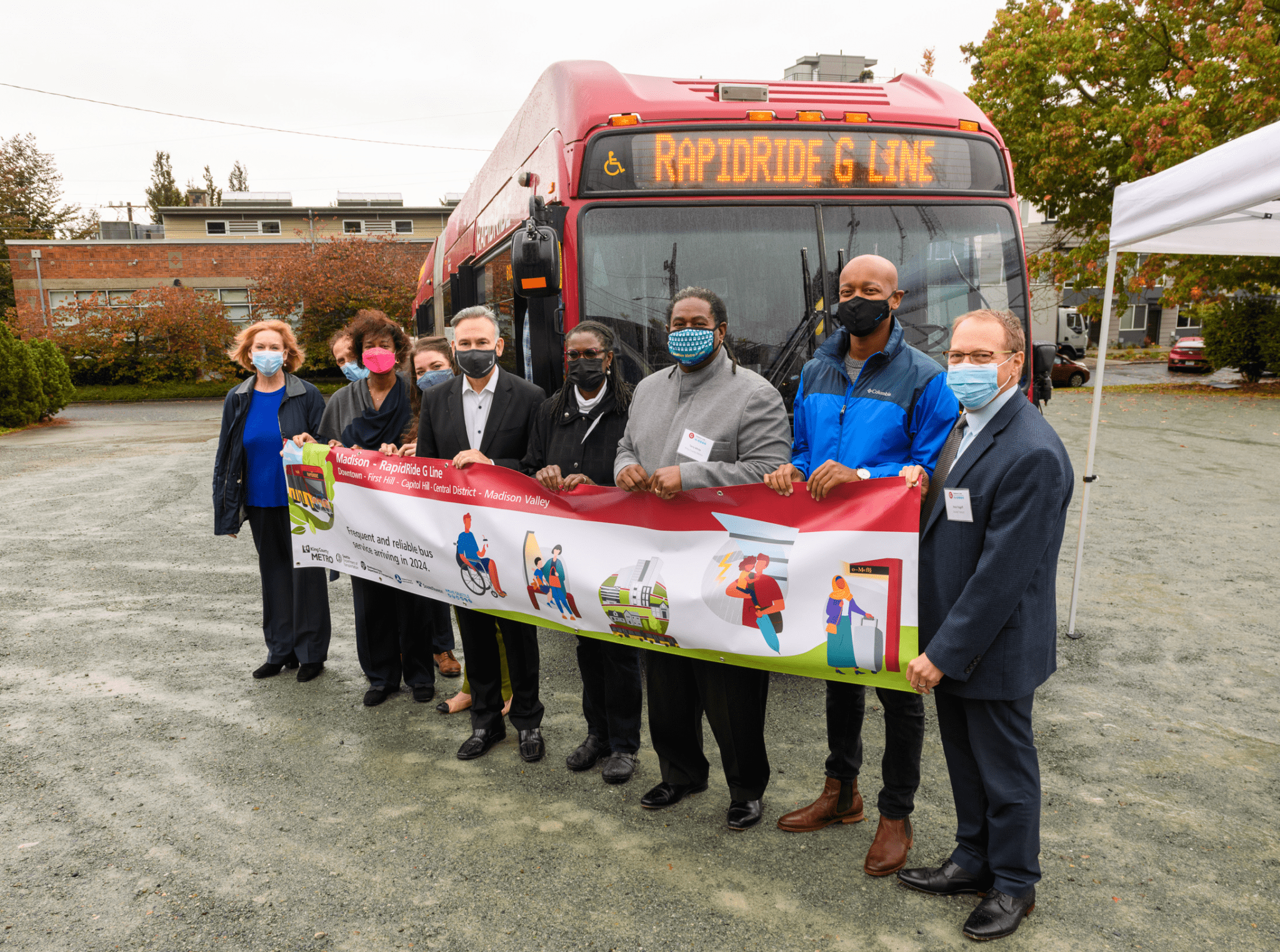 Public transportation leaders and elected officials stand side-by-side with community representatives to celebrate the start of construction on the Madison - RapidRide G Line project at a groundbreaking event in Seattle. Service begins in 2024.
Public transportation leaders and elected officials stand side-by-side with community representatives to celebrate the start of construction on the Madison - RapidRide G Line project at a groundbreaking event in Seattle. Service begins in 2024. Seattle Mayor Jenny Durkan and King County Executive Dow Constantine welcomed Federal Transit Administration Administrator Nuria Fernandez to Seattle today, as they joined other local leaders and congressional delegates at a groundbreaking event to celebrate the start of construction on the Madison – RapidRide G Line. This bus rapid transit (BRT) project is one of Seattle’s biggest projects within the Levy to Move Seattle. When the RapidRide G Line opens in 2024, it will connect some of Seattle’s densest neighborhoods with frequent, reliable transit.
The Madison – RapidRide G Line is a partnership between us, King County Metro, and Sound Transit. It will create a frequent and reliable public transportation line between 1st Ave and Martin Luther King Jr Way. The route will serve dense neighborhoods in downtown Seattle, First Hill, Capitol Hill, the Central District, and Madison Valley. It will connect people to hospitals, schools and universities, and businesses as well as to dozens of bus routes, the First Hill Streetcar, the West Seattle and Vashon Water Taxi at Pier 50, and ferry service at the Colman Dock Ferry Terminal.
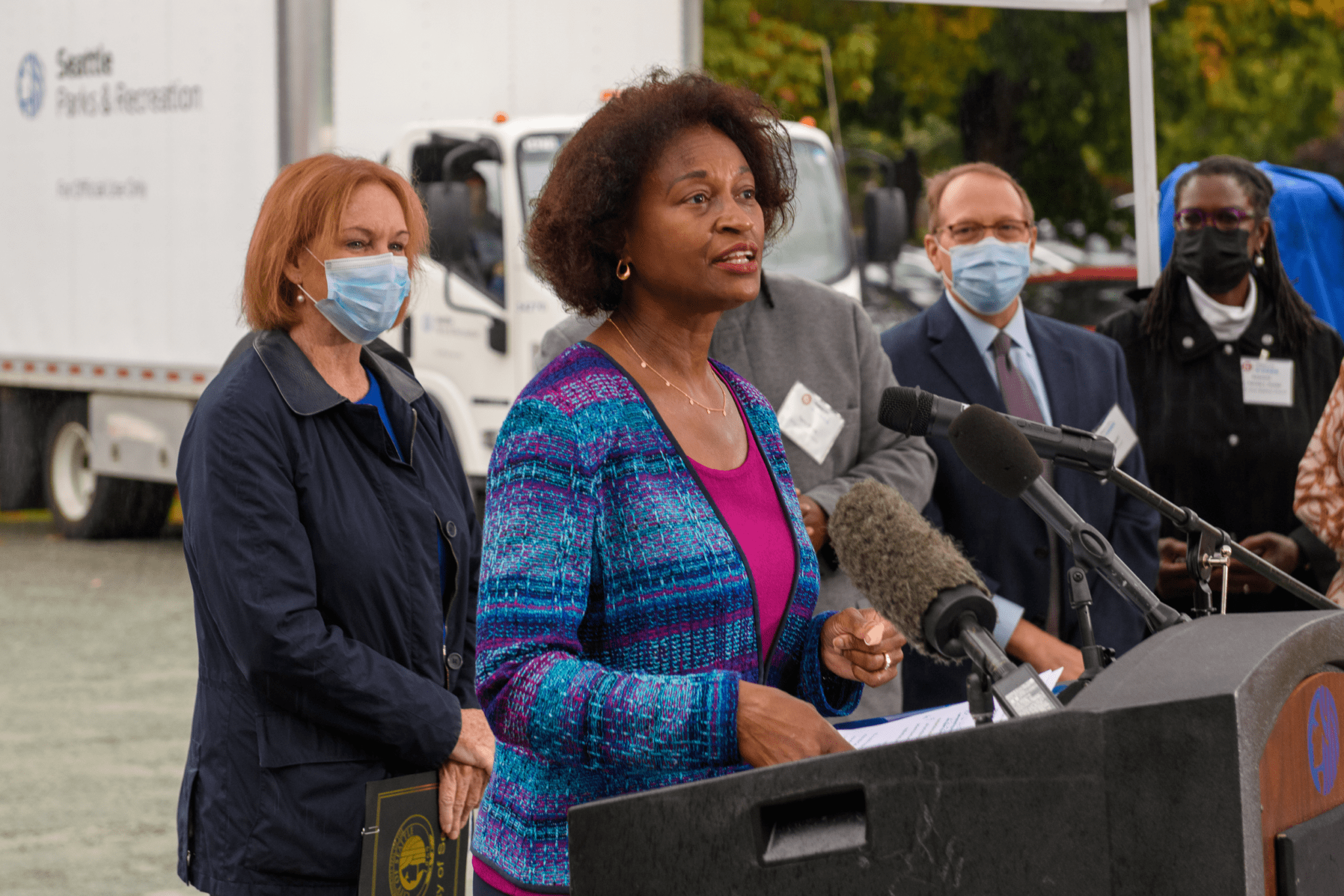
The improved bus route will connect to transit across the region including light rail, ferries, and regional bus lines. A detailed map of the project and how it will connect with Seattle’s larger Transit-Plus Multimodal Network is available online.
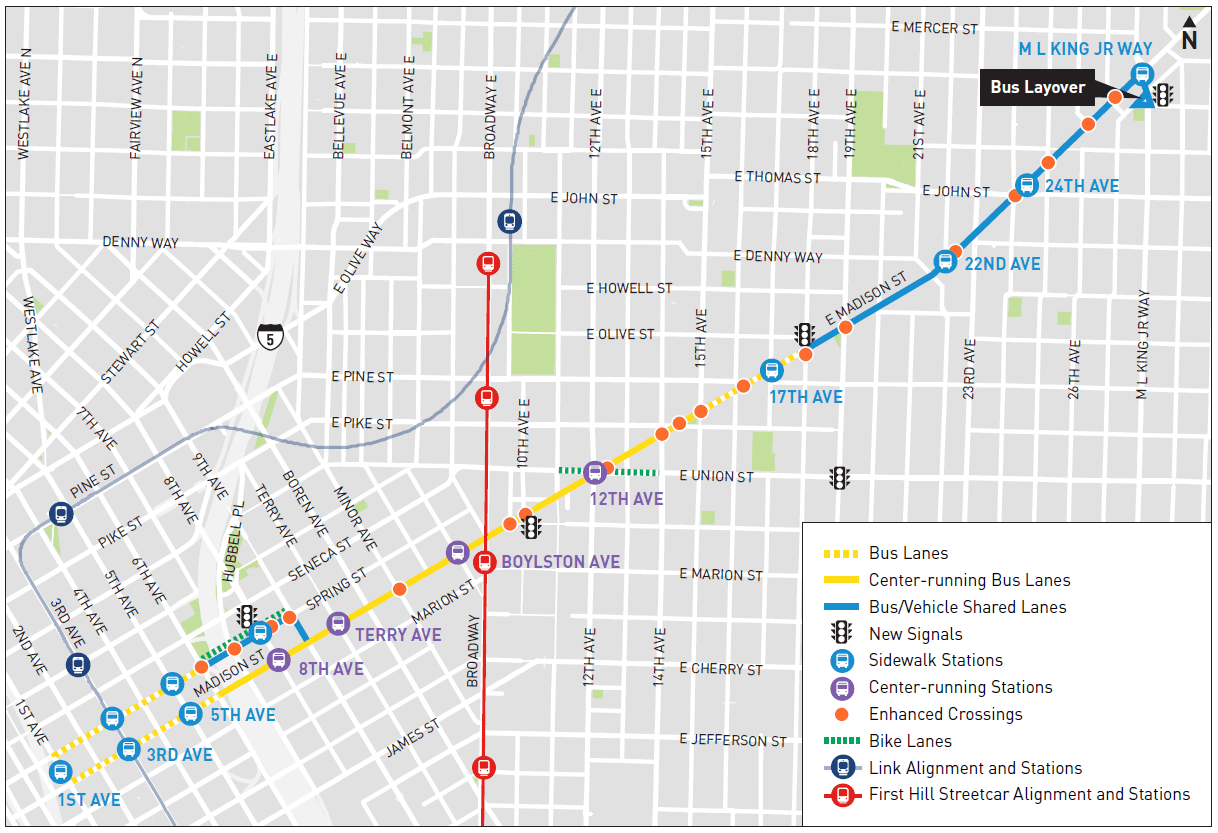
The project will build new sidewalks, repave the street, and change the lane layout to make the bus more reliable, accessible, and easier to get to. We will build curb ramps, add streetlights, and build five new traffic signals with crosswalks to make it safer and more comfortable for people to get to and from bus stops. A complete list of all the many project benefits is available on the project web page, including detailed renderings of the final designs.
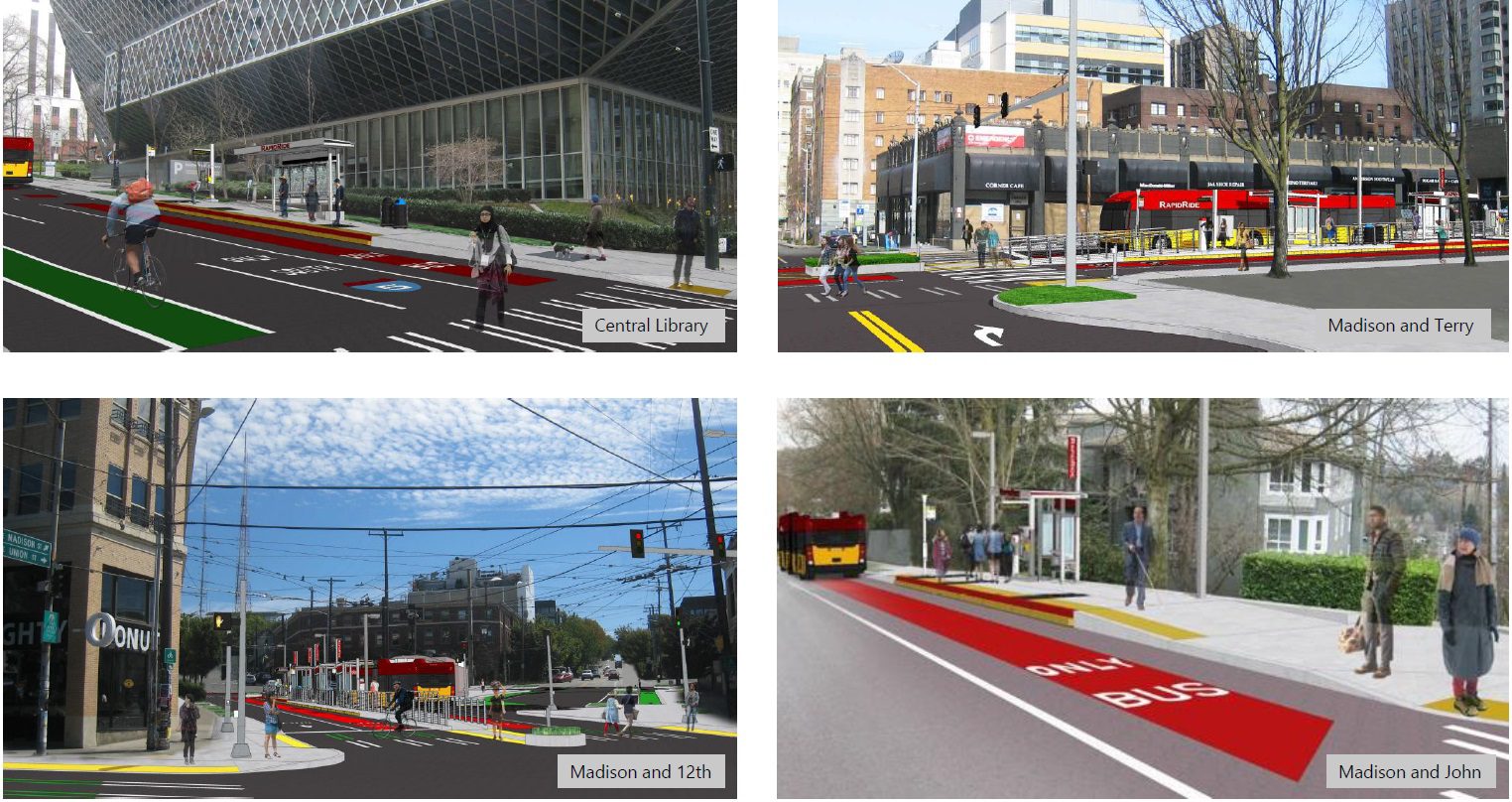
The project would not be possible without the support of Seattle voters who passed the Levy to Move Seattle in 2015. One of the ways which the Levy to Move Seattle amplifies the value of tax dollars is by helping to leverage funding from other regional, state, and federal transit agencies, making it possible for us to accomplish more than would have been possible with local funding alone.
The Federal Transit Administration is contributing $80.5 million to the $133.4 million project. This includes $10.9 million from President Biden’s American Rescue Plan, $59.9 million from the Small Starts Grant program, and another $9.7 million from the Congestion Mitigation and Air Quality Improvement Program. This is the result of years of close collaboration between SDOT and the Federal Transit Administration to meet the rigorous readiness requirements of their grant program.
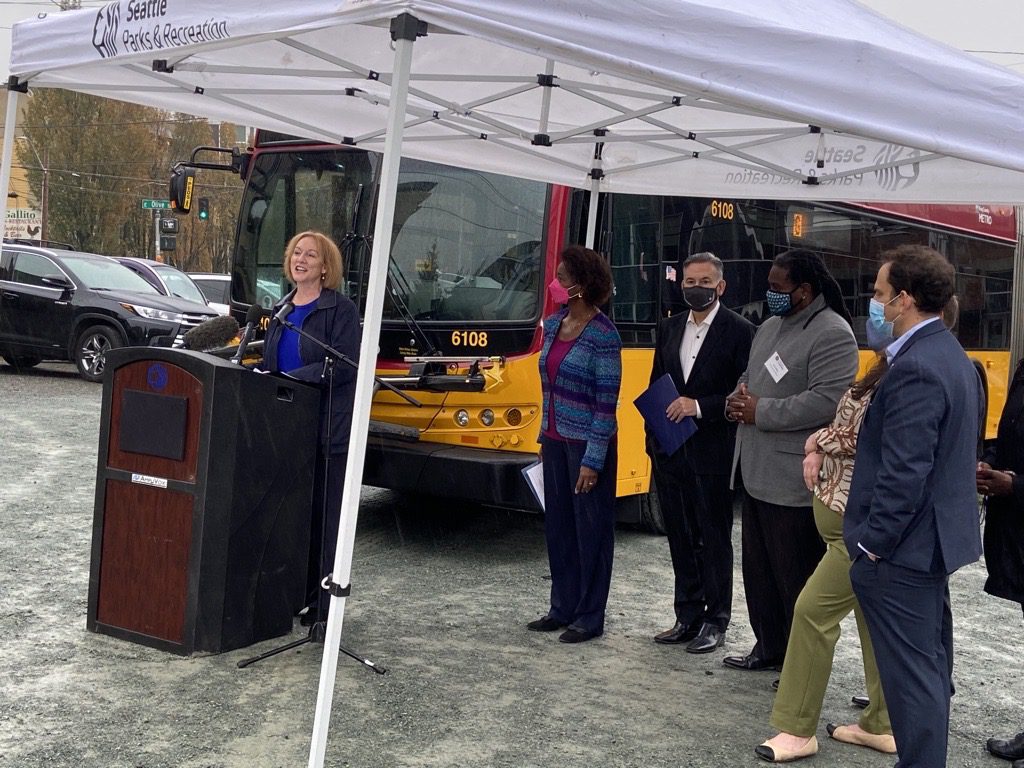
Sound Transit is also contributing up to $35.8 million to the project, as part of a Capitol Improvement Program agreement with us. This project will be one of the first of many Sound Transit 3 commitments which will be completed in the coming years.
The RapidRide G Line is one of many major transit investments the Levy is delivering to create a more connected city, along with other major transit investments like the RapidRide H Line on Delridge Way SW, RapidRide J Line along Roosevelt and Eastlake avenues, and other Transit-Plus Multimodal Corridors throughout Seattle.
We will work to build the project as efficiently as possible while maintaining access and mobility. We will work in sections along the project area and work will generally occur on weekdays between 7 a.m. and 5 p.m. At least one lane of traffic will be kept open in each direction most of the time but there will be some times crews have to close intersections, typically on weekends or overnight.
Quotes from today’s groundbreaking event:
“By making it easier to board, easier to pay and ensuring more buses per hour, the RapidRide G Line will better connect the people of Seattle, encouraging more people to get on board. FTA is proud to join our partners in the Seattle area to expand the bus rapid transit network in western Puget Sound.”
–Nuria Fernandez, Administrator, Federal Transit Administration (FTA)
“While Seattle builds the best transit and transportation infrastructure in the country, support from our federal partners has become even more critical. Senator Murray, Secretary Buttigieg, and the federal delegation have prioritized projects that are good for Seattle, good for jobs, and good for transit. Senator Murray has been relentless in her support of this critical project and other City and regional priorities. As we deal with the effects of COVID-19, it is more important than ever to invest in a transportation system that gets our frontline workers, historically underserved communities and communities of color where they need to go quickly and reliably.”
–Seattle Mayor Jenny A. Durkan
“Breaking ground on the RapidRide G Line marks another expansion of King County’s high capacity transit network. We connect growing communities with the fast, frequent service to get people where they want to be, when they want to be there. From light rail to the Streetcar, to the Water Taxi and ferries – and now RapidRide G – we are building a truly integrated mobility system.”
–Dow Constantine, King County Executive
“The up to $35.8 million dollars that Sound Transit invested in this project will improve the lives of thousands of riders travelling to and from one of Seattle’s dense and vibrant neighborhoods, giving them outstanding connections to our fast-expanding regional transit system. We thank the City of Seattle and King County Metro Transit for leading the partnership to make this project happen, and the Federal Transit Administration for their funding to enable it.”
–Peter Rogoff, CEO, Sound Transit
“Despite the challenges of a global pandemic and recession our transportation agencies continue to deliver excellent projects to the people who depend on transit. The Madison Bus Rapid Transit line gives people in these dense and growing neighborhoods choices when they travel. These are safe, efficient, and affordable choices that together will support healthy and connected communities.”
–Alex Hudson, Executive Director, Transportation Choices Coalition
“Projects like the Madison – RapidRide G Line will transform how people think about mobility in Seattle. We are putting the pieces of a regional, interconnected, and high-quality transit system together. We thank Seattle voters, the Federal Transit Administration, Sound Transit, King County Metro, and all of the community partners who make this project possible. Projects like this one are critical for our commitments to greenhouse gas emissions reduction and safe and reliable transit.”
–Sam Zimbabwe, Director, Seattle Department of Transportation
“We are celebrating the start of a historic groundbreaking and the culmination of a collaborative planning effort with community members and across partner agencies. Working together on a federal, state, regional, and municipal level made the RapidRide G Line a reality. I look forward to returning to the corner of Rev. Samuel B. McKinney and Madison streets to celebrate the start of the RapidRide Service to the neighborhoods it will serve. The G Line will also better connect these neighborhoods with our regional mobility network.”
–Terry White, General Manager, King County Metro